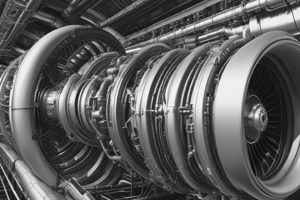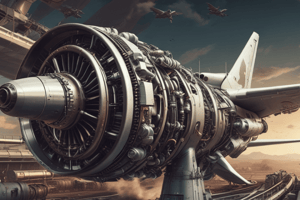Podcast
Questions and Answers
What is the main focus of the lecture on Flight Propulsion and Gas Turbines?
What is the main focus of the lecture on Flight Propulsion and Gas Turbines?
Turbojet engines
What do both aircraft engines and stationary gas turbines consist of?
What do both aircraft engines and stationary gas turbines consist of?
Essentially the same components
What is the purpose of chapter one in the lecture?
What is the purpose of chapter one in the lecture?
To discuss the introduction and importance of propulsion for flight tasks.
What is discussed in chapter two of the lecture?
What is discussed in chapter two of the lecture?
What components are specifically handled with respect to jet engines in chapter three?
What components are specifically handled with respect to jet engines in chapter three?
What is discussed in chapter four regarding engine performance?
What is discussed in chapter four regarding engine performance?
What kind of modifications are covered in chapter seven?
What kind of modifications are covered in chapter seven?
In chapter eight, which two types of engines are discussed?
In chapter eight, which two types of engines are discussed?
What is the main disadvantage of ramjet engines mentioned in the content?
What is the main disadvantage of ramjet engines mentioned in the content?
What type of rocket propulsion systems are discussed in this lecture?
What type of rocket propulsion systems are discussed in this lecture?
Flashcards are hidden until you start studying
Study Notes
Overview of Flight Propulsion and Gas Turbines
- Turbojet engines are primarily covered but the principles can apply to both aviation and stationary gas turbines.
- The subject emphasizes the importance of propulsion in flight and outlines the significance of conservation laws in engine performance.
Lecture Structure
- The lecture consists of eleven chapters focusing first on flight propulsion.
- Chapter one introduces the topic, objectives, and the relevance of propulsion for flight tasks.
Jet Engine Fundamentals
- Chapter two details the simple jet engine, its structure, and the thermodynamic cycle, which is optimized at a defined design point.
- Chapter three addresses components specific to jet engines like the intake and nozzle but also applies to stationary gas turbines (compressor, combustor, turbine).
Engine Performance and Control
- Chapter four discusses engine performance applicable to both jet and stationary gas turbines.
- Chapter five covers engine control and starting procedures, tailored particularly to flight propulsion systems.
- Engine installation and noise considerations are explored in chapter six, relevant to both jet and stationary applications.
Modifications and Variants
- Chapter seven investigates modifications to the simple jet engine including afterburners, turbofan engines, and shaft power engines, all centered around a "gas generator."
Stationary Gas Turbines
- Chapter eight transitions to stationary gas turbines, discussing their operation for peak and base load power generation in conjunction with steam turbines.
Advanced Propulsion Systems
- Chapters nine and ten introduce ramjet and rocket engines, highlighting ramjets' suitability for high Mach numbers and rockets' independence from atmospheric pressure despite limited burn time due to the need for onboard oxidizers.
Additional Notes
- The bibliography provides a list of resources used for the lecture preparation, ensuring comprehensive research backing the material presented.
Studying That Suits You
Use AI to generate personalized quizzes and flashcards to suit your learning preferences.




